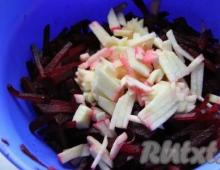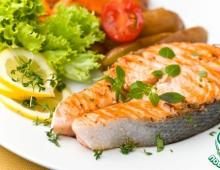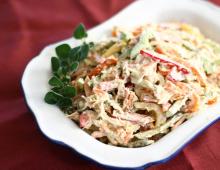Smalets. Lard. What is rendered lard called? Recipe for rendered pork fat 4 letters
Everyone knows about salted lard. Of course, the recipe for such lard will definitely appear on my blog. But today I want to talk about rendered lard or lard.
Why is this product interesting for a bushcrafter, survivalist, hiker, etc.?
Firstly, lard itself is a high-calorie and tasty food.
902 calories per 100 grams of product.
It can be mixed with spices and made into a pate like this.
Secondly, it is a common culinary ingredient. You can fry food with lard, use it instead of butter in dough, etc.
Thirdly, lard is included in all kinds of impregnations.
For example, it can replace drying oil in a recipe for universal wax impregnation.
Fourthly, rendered fat can be included in a variety of homemade cosmetics.
For example, various creams, homemade.
And lard in its pure form can be used as an independent ointment against cold and chapping.
Fifthly, because Animal fat, unlike vegetable fat, does not polymerize; lard can be used to lubricate moving parts.
For example, squeaky hinges. I also came across advice on lubricating the blades of metal hacksaws and thread-cutting tools with lubricant.
Finally, I would like to note the use of rendered fat in folk medicine, for example in the treatment of joints.
But let’s finish with the theory and move on to the method of making lard.
We will need pork fat, also known as lard. Some sources advise using visceral fat, but it is too smelly.
I just bought lard at the market.

First, I washed the lard in water with a little vinegar added.

Then I cut off the skin and cut it into small cubes.

I threw the cubes into a cast iron frying pan and put them on low heat.

The lard will start to melt, sizzle and smell amazing.
We wait until the lard is rendered and the water it contains evaporates. You can tell by the fact that the lard cubes will become transparent.

I repeat that everything must be done over low heat, stirring constantly. Otherwise, the lard itself may burn.
I draw your attention to the fact that the temperature of the heated lard will be around 180 degrees. Don't get burned.
Carefully filter the rendered lard into a clean, dry jar.

Good transparent unburnt lard looks like this.

By the way, the transparent pieces of lard remaining in the frying pan are cracklings, which are also great for eating. For example, I love scrambled eggs with cracklings.
Here is a recipe for multifunctional lard. I recommend trying it.
And that's all for now. Thank you for your attention!
Pork fat is rendered internal pork fat and lard, i.e. subcutaneous fat. For a long time, pork fat, along with other animal fats, has been criticized by scientists and doctors, blamed for increasing the risk of cardiovascular disease, high cholesterol and other ills. Today fat has been rehabilitated and is once again entering culinary practice. True, buying animal fat in the store is still problematic. It is much easier to heat it yourself at home. How to render pork fat will be discussed in this article.
What are the benefits of pork fat?
For many years, the refusal to use pork fat was explained by the risk of high cholesterol, which is the main cause of heart and vascular diseases. It was classified as one of the most unhealthy fats and all our attention was paid to vegetable oils. Now many studies show that they do much more harm than good.
Animal fats consist of saturated, monounsaturated and polyunsaturated fatty acids. Most of the monounsaturated fatty acids are oleic acid, an acid that is abundant in olive oil. It is for its high content of oleic acid that this oil is considered one of the healthiest vegetable oils.
Saturated fats are also important for the human body. We need them to absorb and assimilate fat-soluble vitamins and some other nutrients. For example, when we drink skim milk fortified with vitamin D, it will not be beneficial because it requires saturated fat to be absorbed. And if there is not enough of it, then no vitamin will be absorbed.
In addition, pork fat is rich in vitamins A, E, Omega-3 fatty acids. Not only that, but this fat helps absorb and absorb these important nutrients and vitamins.
The low level of polyunsaturated fatty acids in pork fat means that the fat oxidizes slowly and does not become rancid, i.e. it can be stored for a long time.
Pork fat has a high smoke point, i.e. it can be heated to higher temperatures without fear of releasing carcinogenic substances. It is suitable for frying at high temperatures that many vegetable oils cannot provide.
Which lard to choose
Pork lard is not uniform in quality. For different needs you need to take different lard for rendering fat.
Firstly, the quality of the fat depends on what and how the pig was fed.
Secondly, from which part of the pig carcass will you render the fat?
To make it easier to figure out which fat is best and for which culinary needs to render fat from which part, take note of these tips.
Lard or lard. This is subcutaneous lard, which is usually salted. But it can also be taken for reheating. It is sold in the market or in the store in pieces. This lard is great for frying and stewing.
Fat from the belly or underbelly. Soft layered fat with meat. Bacon is mainly made from this part. This lard is suitable for frying.
Internal lard or internal fat. This is the fat that is located on the internal organs of the pig. It is cut in layers and is soft. This is the purest fat. After melting, the fat will be white, practically odorless and tasteless. 
The fat rendered from such lard is highly valued by bakers. It is added to the dough, greased with pies to get a fragrant, beautiful crust. It always remains soft.
How to render pork fat at home
The technology for preparing and rendering pork fat is the same regardless of which part of the carcass you are rendering it from.
You can render fat on the stove, in the oven, or in a slow cooker. There are two different ways to obtain fat.
Wet method. Place the chopped fat in a saucepan with a little water. Turn on the stove and bring to a boil. Reduce until the water simmers and melt the fat until it melts in the water. Cool and pour into a jar. This method is suitable for both rendering internal fat and lard.
Dry method. This method can be used to render fat on the stove, oven, slow cooker, or frying pan. Heat the container in which you will heat the fat and place the chopped fat in it. This method can be used to render both interior fat and lard. While rendering fat using this method on the stove or in a slow cooker, stir it periodically with a wooden spatula.
How to render lard into fat
First you need to cut into small cubes, no larger than 1x1cm. Like this 
The finer the lard is cut, the faster it will melt and the more finished fat you will get. You can grind it in a meat grinder.
Place the chopped lard into a saucepan. Add water. For 1.5-2.0 kg of lard, approximately 200-300 grams of water.
Cover with a lid and place on the stove. As soon as the pan is well heated and the first bubbles appear on top, reduce the heat. Fat should be rendered at the lowest possible temperature. When rendered at high temperatures, fat melts faster, but it turns out darker in color, and may even be brown.
Approximately once every half hour, the fat should be carefully mixed with a wooden spatula. The entire process of rendering this amount of lard can take from 4 to 5 hours.
Strain the rendered fat through a sieve to separate the cracklings and pour into clean, dry jars. Once it cools to room temperature, put it in the refrigerator.
How to render pork fat in the oven
The best thing about melting fat in the oven is that you prepare it, put it in a pan, and you can go about your business while the fat is melting.
The preparation of fat is the same as for rendering on the stove. First you need to finely chop the pieces of lard or interior fat. The smaller the better. You can twist it in a meat grinder.
Place everything in a pan that can be placed in the oven. It is good to heat in cast iron.
Preheat the oven to a temperature of about 105-110 degrees. Place the pan in the oven. The rendering time depends on the amount of lard. The more lard, the longer the fat is rendered. You can carefully remove the pan and stir. Just be very careful so as not to burn your hands with fat.
Separate the rendered fat from the cracklings and pour into glass jars.
How to render internal pork fat
Internal fat is soft and layered. Almost all of it is melted away.
Cut the fat into small pieces. Place in a saucepan.
Add approximately 500-100 ml of water depending on the amount of fat. You don't need to pour a lot of water. It turns out to have a softer consistency compared to fat from rendering lard.
Place on the stove over low heat. After about an hour, check the pan and stir. It is very important not to let the fat burn at the very beginning. 
When melting, it will form cracklings, which will gradually settle to the bottom.
Strain the rendered fat through a sieve or cheesecloth and pour into jars.
Regardless of what you render the fat from, the most important thing at the initial stage is to clearly regulate the temperature. If the stove is heated too much, the lard may burn.
Until the first rendered fat appears, you need to monitor this process and stir the lard in a timely manner.
As soon as a certain amount of fat is rendered, the remaining pieces will boil in it, giving off fat.
You need to stir periodically. This will ensure that all the pieces of lard are rendered more evenly.
There is no need to render the fat until the cracklings are crispy. They should remain soft and light. They can then be further fried separately until they become brown and crispy. They can be used for stewing potatoes or other dishes. Fried cracklings can be sprinkled, for example, on potato salad.
Properly rendered fat in a glass jar should be pale yellow. When it hardens, it will turn white.
Before pouring it into jars, cool the fat so that the jars do not crack and your work is not in vain.
Fat should be stored in a cool place. Can be frozen.
Pork fat can be stored in such conditions for a long time, more than a year.
How to use pork fat
Pork fat can be used in the same way as vegetable oil. You can fry meat, vegetables, and stew in it. The dough is made with pork fat. Only for baking it is better to take only internal fat and preferably in the area of the kidneys.
The recent fashion for everything natural dictates its own rules. And often, under its influence, we have to not only invent something new, but also turn to the roots. Take, for example, rendered lard - an indispensable product in the household that was known to our ancestors many centuries ago.
Today, briquetted lard can be bought in any supermarket. Or you can prepare it yourself - you can verify the quality of the raw materials personally, and monitor compliance with the technology from start to finish, and even save money. And in order for the result to reward the efforts, we first study the materiel. So, let's look at all the intricacies: what is melted lard called, how is it prepared and what is it eaten with? And besides, we’ll find out how it can be used on the farm.
What is rendered lard
Melted fat is widely used in the household. It’s very easy to prepare it yourself, and it keeps well for quite a long time. When heated, pork fat completely changes its structure, moving from solid to liquid. Later, as it cools, it thickens again. Moreover, this process does not even require very low temperatures - room temperature is enough.
Selection of raw materials and preparation for heating
The pork carcass has several large layers of fat. They are softer in structure than lard, easier to cut into pieces and even crumble by hand. Most of these layers are located in the abdomen and chest of the animal, under the skin and inside cavities. When cutting, they are simply cut off in layers. Regular lard is also suitable for harvesting, especially thin and soft lard from the belly. It is desirable that it does not contain meat layers.

Another part of the carcass suitable for heating is the mesentery - a fatty mesh that supports the internal organs of the animal. It is suitable not only for kindling, but also for preparing various dishes. It is stuffed with liver, blood, minced meat or other filling, and then baked in the oven. But if for some reason this is not possible (for example, the mesh is damaged during cutting), then wonderful lard can be made from it. The recipe for making rendered fat from the mesentery and fat layers is almost identical.
When purchasing raw materials for homemade lard, we follow the same safety measures that are true for choosing any meat and offal: healthy appearance, pleasant smell, visual integrity. It is very good if there is a proven supplier that you trust.
Method of preparing lard
To prepare homemade rendered pork fat, thoroughly rinse the layers, let them dry a little, and if possible remove excess water with paper towels.
It is convenient to cook rendered lard in a wide cast-iron frying pan. We warm it up well and load our workpiece. We control the heating process without distraction to prevent burning and splashing of fat. Stir with a wooden spatula, distributing the pieces evenly throughout the pan so that they heat evenly.

There is more and more boiling transparent fat, and the pieces have become very dark and decreased in volume? Great, that means everything is going as it should. Let's move on to the next stage.
We place cleanly washed and dried glass jars on the table. We attach gauze folded in 3-4 layers to the neck of the dish. This can be done using a rubber band. Using a ladle or large spoon, pour hot homemade lard. The cloth will filter out unmelted bits, preventing them from getting into the jar. Let cool at room temperature, covering with pieces of clean cloth. When it cools down, cover with regular ones. And if necessary, jars of hot lard can be immediately rolled up with metal lids.
Storage at home
Melted lard poured into jars is perfectly stored in the refrigerator or cellar. Moreover, it itself is a preservative. For example, many housewives know the method of preparing pork liver, when the insides, boiled until tender, are twisted in a meat grinder or finely chopped, put in clean jars, poured with hot lard and rolled up. Such preparations can be stored for several months.

Rendered lard can also be frozen in the freezer. Of course, if space allows. There is no particular need for this; it is perfectly stored even at above-zero temperatures.
Use in preparing various dishes
There are many ways to use lard in cooking. The most common one is to replace vegetable oil or butter with pork fat when frying. prepare frying for first courses, fry cabbage rolls, cutlets, meatballs on it.
Lard is often included in baked goods. Replacing some of the butter with rendered pork fat makes the dough smooth and soft. This dough molds well and holds its shape. Homemade lard can also be used to prepare fish and liver pates. The cooking recipe is almost no different from the classic one (with butter). Except that in terms of cost it wins significantly.

Tourists also highly respect this product. Melt lard at home, add chopped herbs, salt, spices to the hot fat, squeeze out a few cloves of garlic. Take this preparation with you on a hike, and it will become a real lifesaver! Just add a couple of spoons to a cauldron of porridge and the magical aroma will spread throughout the entire forest. And not only in porridge. Fragrant homemade lard will brighten up any camp recipe, be it kulesh, fish soup or regular instant noodle soup.
outside the kitchen
Who said that lard can only be used in the kitchen? It has many more uses.
Anyone who has been in the army knows you can lubricate your shoes. The leather wears out faster, does not allow moisture to pass through, and shines dullly. Lard is also widely used in folk medicine and home cosmetology as a base for ointments, rubs and creams. It is also suitable for lubricating squeaking door hinges.
In general, try making homemade lard yourself, and this recipe will definitely take its rightful place in your culinary repertoire.


